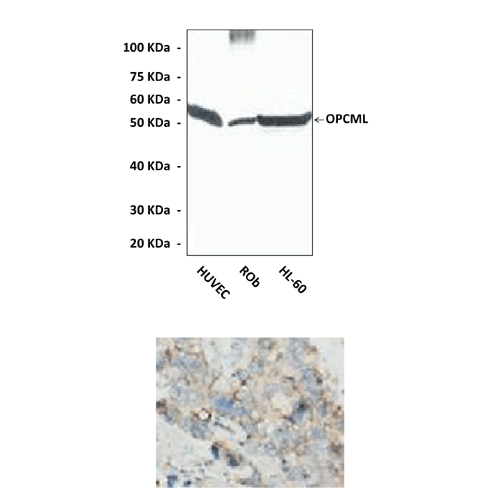Description
BACKGROUND OPCML belongs to the IgLON family of immunoglobulin (Ig) domain containing glycosylphosphatidylinositol (GPI)-anchored cell adhesion molecules, which includes OPCML, LSAMP, NEGR1 and HNT. OPCML is localized in the plasma membrane and may have an accessory role in opioid receptor function. It has an ortholog in rat and bovine. Rat OPCML binds opioid alkaloids in the presence of acidic lipids, exhibits selectivity for mu ligands and acts as a GPI-anchored protein.1 Whereas OPMCL has been shown to exhibit various fundamental roles in mammalian systems. The IgLON proteins are typically composed of three Ig domains tethered to the surface of cell membrane by anchoring of their hydrophobic tails to GPI. IgLONs have been suggested to play an important role in cell adhesion and cell-cell recognition, through both homo- and hetero-philic interactions within the family. It has been proposed that IgLONs function mainly as heterodimers called Diglons. As a cell adhesion molecule, OPCML comprises several protein-protein interaction domains, such as three ‘C2’ like Ig domains which are more appropriately classified as ‘I’ set Ig domains, commonly found in cell-surface-adhesion and receptor molecules. Through these domains, OPCML may bind directly to growth promoting or inhibitory molecules and modulate their functions in tumor cells. Among the IgLON family, OPCML was the first member reported to possess tumor suppressor functions in epithelial ovarian cancer, being frequently silenced genetically and epigenetically at the early step of ovarian carcinogenesis. OPCML probably functions as a tumor suppressor through interacting with other IgLONs to form heterodimeric complex involved in signal transduction.2 Loss of OPCML reduces the intercellular adhesion and heterodimeric complex formation and thus impairs the corresponding signaling pathways, thereby promoting the progress of carcinogenesis. OPCML is a stress- and p53-responsive gene, but this response was often epigenetically impaired by promoter methylation. It is suggested that epigenetic silencing of OPCML would impair the cellular protective response to environmental stresses in normal cells, thus promoting the development of cancers.3 Additionally, elevation of the RAS signaling pathway may play an important role in epigenetic inactivation of OPCML in human epithelial ovarian cancer.4
REFERENCES
1. Izykenova, G.A. & Taranova, N.P.: Nerv Sist. 30:43-50, 1991
2. Czekierdowski, A. et al: Neuro. Endocrinol. Lett. 27:609-13, 2006
3. Cui, Y. et al: PLoS ONE 3:e2990, 2008
4. Mei, F.C. et al: FASEB J. 20:497-9, 2006
2. Czekierdowski, A. et al: Neuro. Endocrinol. Lett. 27:609-13, 2006
3. Cui, Y. et al: PLoS ONE 3:e2990, 2008
4. Mei, F.C. et al: FASEB J. 20:497-9, 2006
Products are for research use only. They are not intended for human, animal, or diagnostic applications.

Top: Western Blot detection of endogenous OPCML proteins from various normal primary cell lysates using OPCML Antibody. The predict molecular weight of OPCML is 34 kDa. Due to post-translational modifications, the actual molecular weight of mature OPCML in the SDS-PAGE gel is 51 kDa. HUVEC: Human Umbilical Vein Endothelial Cells; ROb: Rat Osteoblasts.
Bottom: Immunohistochemical staining of paraffin-embedded human stomach cancer tissue, using Anti-OPCML.
Details
|
Cat.No.:
|
CA1797
|
|
Antigen:
|
C-terminal sequence of human OPCML
|
|
Isotype:
|
Affinity-purified rabbit polyclonal IgG
|
|
Species & predicted
species cross-
reactivity ( ):
|
human, rabbit, rat, mouse
|
|
Applications &
Suggested starting
dilutions:*
|
WB 1:500 to 1:1000
IP n/d
IHC (Paraffin) 1:50 to 1:200 ICC n/d
FACS n/d
|
|
Predicted Molecular
Weight of protein:
|
51 kDa
|
|
Specificity/Sensitivity:
|
Reacts specifically with OPCML of human, rabbit, mouse & rat origin in immunostaining applications, and does not cross-react with other members of the IgLON family.
|
|
Storage:
|
Store at 4° C for frequent use; at -20° C for at least one year.
|
*Optimal working dilutions must be determined by end user.
